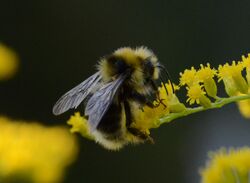Biology:Bombus semenoviellus
| Bombus semenoviellus | |
|---|---|

| |
| Scientific classification | |
| Domain: | Eukaryota |
| Kingdom: | Animalia |
| Phylum: | Arthropoda |
| Class: | Insecta |
| Order: | Hymenoptera |
| Family: | Apidae |
| Genus: | Bombus |
| Species: | B. semenoviellus
|
| Binomial name | |
| Bombus semenoviellus Skorikov, 1910
| |
Bombus semenoviellus is a species of insect belonging to the family Apidae.[1]
It is native to Europe.[1]
Description
Range
The species has been invading towards west in recent years. The westernmost location so far is in Lower Saxony; from here eastwards to Tuva, east of this only one report from Panfilov et al. 1961 from Sakha / Yakutia; northwards to southern Norway (first discovered here in 2013 in Hvaler; no evidence from Sweden), in Finland to the Arctic Circle, in Russia to Karelia, Arkhangelsk, Komi and Perm; south to Bavaria, Northern Austria, Slovakia, Ukraine and Orenburg. In Germany , the first record for Central Europe was made in Schleswig-Holstein in 1998 (van der Smissen & Rasmont 2000), in the following years the species was also reported from Brandenburg, Saxony, Thuringia, Saxony-Anhalt, Bavaria, Mecklenburg-Western Pomerania and Lower Saxony. In Austria, a find from 2009 from the Waldviertel in Lower Austria is known to date (Streinzer, 2010).[2]
Habitat
Originally sparse boreal coniferous forests of the southern taiga. Also forest steppe, extensively used grassland, semi-arid grassland, ruderal areas, wet meadows. From the lowlands to the colline altitude.[2] In Central Europe, forest clearings, forest paths and forest edges, but also diverse and flower-rich cultural landscapes such as meadows, ruderal areas, gardens and parks near human settlements with a warm, dry summer character (Frommer 2018).[3]
Ecology
Occurs from late April to late August. Overwintered females appear from the end of April, young males in July.[3] This is a polylectic species. During the summer colony development phase, Asteraceae are preferred as fodder plants.[3] Nests underground in abandoned mouse cauldrons. Pollenstorer.[3] The colonies are not very strong in individuals.[2]
Etymology
Named after the Russian entomologist Andrey Petrovich Semyonov Tyan-Shansky (1866-?), Who collected parts of the type series.
Taxonomy
Subgenus Cullumanobombus VOGT, 1911[2]
References
- ↑ 1.0 1.1 "Bombus semenoviellus Skorikov, 1910" (in en). https://www.gbif.org/species/1340281.
- ↑ 2.0 2.1 2.2 2.3 Scheuchl, Erwin (2016). Taschenlexikon der Wildbienen Mitteleuropas : alle Arten im Porträt. ISBN 978-3-494-01653-5. OCLC 1041414212. http://worldcat.org/oclc/1041414212.
- ↑ 3.0 3.1 3.2 3.3 Westrich, Paul (2019). Die Wildbienen Deutschlands. ISBN 978-3-8186-0881-1. OCLC 1190164412. http://worldcat.org/oclc/1190164412.
Wikidata ☰ Q2491030 entry
 |


